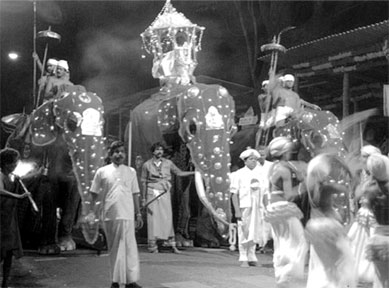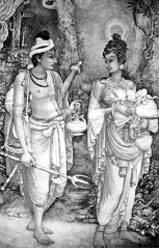|
Esala pageant in the hills:
The glory of a spiritual odyssey
By Kalakeerthi Edwin ARIYADASA
|

The Kandy Perahera
|
“Festivals of many types serve to meet
specific needs as well as to provide entertainment. These times of
celebration offer a sense of belonging, for religious, social or
geographical groups. Modern festivals that focus on cultural or ethnic
topics seek to inform members of their traditions”.
We have to begin with a stark, formidable, cultural and spiritual
truth. The spectacular annual pageant of Kandy is not at all a mere
recurrent routine event. For the masses of this sacred land, the Esala
spectacle of the Central Hills is a total renewal and regeneration of
life. In this instance, it is on par with Sri Lanka’s New Year
festivities, which are entrenched in the cultural system of our people
as a fresh re-awakening of the whole process of life.
For those who reside in the hinterland of the venue of the Esala
pageant, the perahera season is the time of fulfilment. They yearn to
achieve what they failed to accomplish last time.
They curb and restrain their urges “until the Kandy perahera comes
round.” For ages - sociologists would agree here, I am sure - the Esala
pageant has continued to be a profoundly transforming force.
For newly-weds, watching the perahera together is a romance
culminating moment - since watching the pageant in each other’s company
is a subtle condition of courtship. For young couples, seeing the
perahera with their new-born is a climatic point in their nuptial
satisfaction.
Over the centuries, massive spiritual and cultural streams have
converged upon the Esala pageant. A complex of traditions has
accumulated around the pageant, forming into an aura of religious and
cultural webs.

Prince Danta and Princess Hemamala a bring the Sacred Tooth
Relic to Sri Lanka |

The Day Perahera |
Any item in the pageant - it could be minute or large - may very well
be the outcome of long years of evolution. The decorations, the
costumes, the rites and the rituals, and even the mannerisms of those
who form part of the pageant are evocative of a long-sustained tradition
that point back to a far past.
Dramatic episodes
And the dramatic episodes from which the Esala pageant originated can
very well be described as a “spiritual romance” or a “religious odyssey”
- although they may seem contradictions in term.
In the spiritual annals of human history, I am not too sure whether
one could find a story to parallel the arrival of the Sacred Tooth Relic
in Sri Lanka. The fervent religious devotion with which the masses pay
their homage to the Sacred Tooth Relic has muted this dramatic spiritual
odyssey into an undertone.
The spectacle and the pageant of the perahera are so overwhelming
that the masses can barely find any time to spare a moment to give even
a passing thought to the religious adventure that made all this
possible.
Epic drama
The ‘Sacred Tooth Relic Odyssey’ is replete with all the elements
that go to make an epic drama. Miracles are abundant. Kings, emperors,
princes and princesses provide a pulsating rhythm to the legend.
Daring voyages in disguise give the events a heightened appeal. The
hallowed spiritual core of all these various streams elevates the sacred
trek into a timeless dimension.
After centuries, film-makers have been allured by the absorbing
depths of this holy epic.
We can only hope that those who are after the cinematic implications
of this sacred saga will go about their film-making without even
slightly impairing the quintessential holiness of the material they have
opted to approach.
The film-making effort is a new development in the traditions
associated with the Sacred Tooth Relic. Because of the sensitiveness of
this material, the film initiative will receive much public scrutiny.
The Kalinga King Guhaseeva was prepared to sacrifice his life and his
kingdom for the safety of the Sacred Tooth Relic. To ensure unswerving
commitment to the safeguarding of the Sacred Tooth Relic, the King gave
his daughter Hemamala to Prince Danta, who was the custodian of the
Sacred Tooth Relic. (Incidentally, he is the forerunner, ancestor and
the pioneer of all Diyawadana Nilames.)
It is soul-stirring to think about these two people trekking along,
disguised as a wandering Brahmin couple. Hemamala had the Sacred Tooth
Relic concealed in her coiffure.
One could imagine the risks they ran travelling from Kalinga to Sri
Lanka, with such a precious secret with them. At each Esala pageant,
they should occupy a legendary position in the collective memory of Sri
Lankans.
The process of renewal is going on apace at the Sacred Temple of the
Tooth.The Diyawadana Nilame and the staff have introduced initiatives to
widen the scope of the features associated with the traditional aspects
of the shrine.
The visitors will come upon an exhibition of photographs relating to
the Temple of the Sacred Tooth Relic and its history.
Devotees from all over the world will notice in this year’s annual
pageant a fresh glow that enhances the shrine’s perennial glory.
The procession
The Dalada Perahera begins with the Kap Situveema; a young jak tree
is cut and planted in the premises of each of the four Devales dedicated
to the Guardian Gods Natha, Vishnu, Kataragama and Goddess Pattini.
For the next five nights, the Devale Peraheras take place within the
premises of the four Devales with the priest of each Devale taking the
pole every evening, accompanied by music and drumming, flag and canopy
bearers and the Ran Ayudha, the sacred insignia of the Gods.
The Kumbal Perahera begins on the sixth night and continues for five
days. Initially, the Devale Peraheras assemble in front of the Temple of
the Tooth, with their insignias, accompanied by the Basnayake Nilames.
The relic casket is placed in the ransivige and affixed to the
Maligawa Tusker and the Maligawa Perahera joins the awaiting Devale
Peraheras and leads the procession. Whip-crackers and fireball bearers
clear the path, followed by people bearing Buddhist flags. Riding on the
first elephant is the official called Peramuna Rala followed by Kandyan
drummers and dancers . The Diyawadana Nilame walks in traditional
Kandyan splendour after the tusker.
The second procession is from the Natha Devale, which faces the Sri
Dalada Maligawa.
The third is from the Vishnu Devale, also known as the Maha Devale.
The fourth procession is from the Kataragama Devale which is on
Kotugodalle Vidiya. This procession includes Kavadi dancers.
The fifth and final procession is from the Pattini Devale with women
dancers.
The Randoli Perahera begins after five nights of the Kumbal Perahera.
Randoli were palanquins on which the then queens traditionally
travelled. This is the most vibrant and colourful segment of the
perahera and is held over five days with the Maha Randoli Perahera on
the last day.
The Dalada Perahera ends with the Diya Kepeema, the water-cutting
ceremony, at the Mahaweli River at Getambe, a few miles from Kandy. A
Day Perahera is held to mark the ceremony. |

